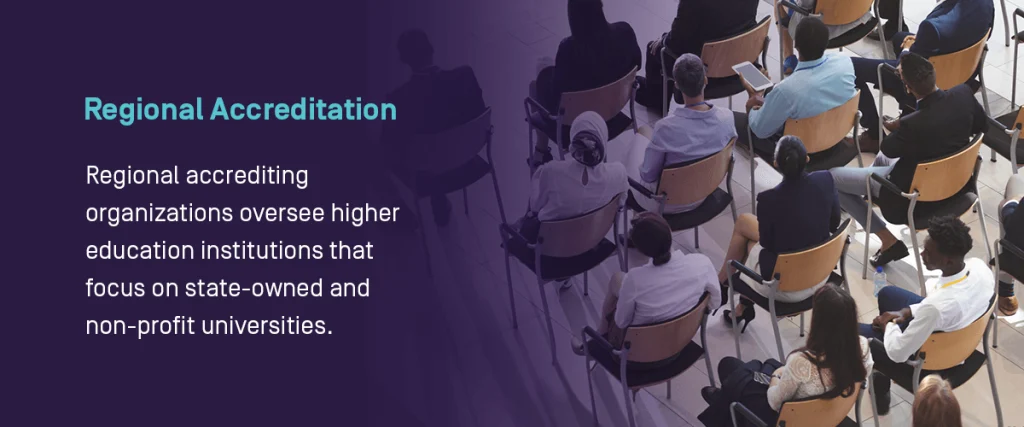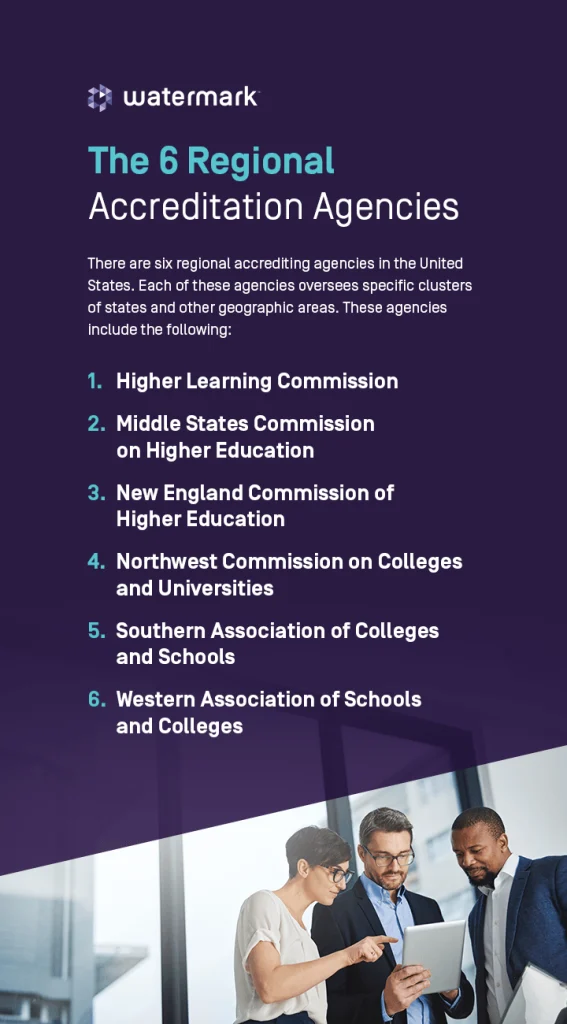



Higher education accreditation refers to a quality-assurance process for post-secondary institutions. The two major types of accreditation are national and regional. (Regional accreditation is now often referred to as institutional accreditation. This change happened after the Department of Education repealed the regional monopoly rules in 2019, allowing accreditors to cross into each other’s territory and compete.) When an institution is accredited, this indicates that the school offers an exceptional educational experience and meets certain standards set forth by a certified agency. There are currently 10 different agencies for granting national accreditation and six for granting regional/institutional accreditation.
When comparing regional/institutional vs. national accreditation, there are some major differences to be aware of. Learn more about accreditation and the various regional/institutional agencies responsible for evaluating higher education institutions within their geographic jurisdiction.

National accreditation agencies extend endorsement and approval to higher education institutions that offer degrees and certifications. Most nationally accredited schools fit into the following categories:
Industries and career fields that require specific licensure often have national accreditation. These programs are typically less expensive than those of regionally/institutionally-accredited institutions. They also tend to be mostly for-profit and earn their revenue through enrollment practices and selling educational products. Approved institutions usually have more relaxed and less complicated admission standards as well. This type is also largely focused on programs, schools, and departments within a higher education institution rather than the school as a whole.
When it comes to transferring credits between academic organizations, nationally accredited schools recognize credits from other nationally accredited schools. This is important for individuals looking to transfer credits to another institution. While national accreditation may seem like it is a more prestigious award than regional/institutional accreditation, this is not typically the case. Most regionally/institutionally accredited schools do not accept credits from institutions that are nationally accredited.

Regional accrediting organizations (which are now referred to as institutional accrediting organizations after the Department of Education repealed the regional monopoly rules in 2019) oversee higher education institutions that focus on state-owned and non-profit universities. Is regional/institutional accreditation good? The answer is yes — regional/institutional accreditation is the most esteemed and widely-recognized type of accreditation.
Regional/institutional accreditation is good for students who want to transfer credits between institutions. Both nationally accredited and regionally/institutionally accredited schools often accept credits from regionally/institutionally accredited schools.
Most regionally/institutionally accredited higher education institutions have stricter admission standards and a more selective admissions process. These institutions are usually more expensive than other schools as well. They are also typically non-profit organizations that fundraise through the following methods:
Unlike national accreditation, this type is also known as institutional accreditation because agencies award the entire institution, including main and off-campus instructional sites.

There are six regional/institutional accrediting agencies in the United States. Each of these agencies oversees specific clusters of states and other geographic areas. These agencies include the following:
The Higher Learning Commission (HLC) accredits degree-granting higher education institutions in America. HLC serves the following states:
HLC was founded in 1895 and currently has headquarters in Chicago, Illinois. It was originally part of the North Central Association of Colleges and Schools before the association’s dissolving in 2014.
Both the United States Department of Education (ED) and the Council for Higher Education Accreditation (CHEA) give recognition to the commission as a post-secondary educational institution accreditor. The commission maintains a close relationship with its member institutions through regular reviews and lots of communication.
There are two different routes that degree-granting colleges and universities can take to receive accreditation from the Higher Learning Commission. The institution can achieve accreditation from the Eligibility Process and Candidacy, in which a higher education institution applies for HLC membership. The school must be in the United States of America and have a substantial presence to be eligible to apply.
If the institution is currently accredited by another historically regional accrediting agency, it can seek approval through the Accelerated Process for Initial Accreditation. The institution must also have no history of being placed on a sanction or other negative action while also meeting all of HLC’s requirements. This process allows applicants to apply for initial accreditation without having to serve a period of candidacy.
For schools looking to maintain accreditation, HLC conducts frequent reviews to ensure every member institution is adhering to the expectations of the commission. HLC performs evaluations for the following reasons:
HLC members must pay dues and fees on an annual basis to maintain membership and remain accredited.
Download Watermark’s Essential Guide To HLC Accreditation for additional insights into the process.
The Middle States Commission on Higher Education (MSCHE) is an accreditation association that covers more than 525 degree-granting institutions in the following states and regions:
MSCHE was once part of the Middle States Association of Colleges and Schools (MSA) when it was established in 1919. Originally, MSCHE was one of three commissions of MSA. In 2013, MSCHE established itself as a separate entity and, in 2019, MSCHE withdrew from the association entirely. The commission currently has headquarters in Philadelphia, Pennsylvania.
The application process for acquiring accreditation from MSCHE involves three main phases. It begins with a pre-application that takes anywhere from four to five months. Then, the next phase involving the official application can take about 15 to 18 months. MSCHE either grants an institution candidate status during the final phase or rejects their application. MSCHE conducts reviews at every stage. The pre-application process review includes the following:
The application process review includes the following:
Finally, the grant of candidacy review from MSCHE includes:
Candidates must pay MSCHE at every step of the process, from pre-applicant inquiry fees to paying for applicant assessment team visits. MSCHE reviews its member institutions as part of an eight-year cycle. Colleges and universities must complete a self-study process and on-site evaluation from peer evaluators.
Peer evaluators also conduct something called a Mid-Point Peer Review (MPPR). The MPPR data report includes five years’ worth of accumulated data indicators from the Annual Institutional Update (AIU) to ensure the institution is financially healthy and prioritizes student achievement. This is MSCHE’s way of keeping accredited higher education institutions striving for more.
Download Watermark’s Essential Guide To MSCHE Accreditation for additional insights into the process.
The New England Commission of Higher Education (NECHE) is a regional/institutional accreditation agency that serves the following states:
In addition to these six states, the commission serves international locations such as Bermuda and Bulgaria. It accredits over 200 institutions in the New England region and abroad. NECHE began operations in 1885 and has its headquarters in Burlington, Massachusetts.
The process for earning accreditation from NECHE begins with eligibility. Institutions seeking membership must meet the Requirements of Affiliation to be eligible for candidacy. In addition to meeting these requirements, colleges and universities must have clear intentions of meeting NECHE’s Standards for Accreditation and an established plan to further comply with the commission’s criteria.
Then the institution can apply for candidacy and take on self-study efforts to further align with the standards set forth by NECHE. After this, the commission completes a series of on-site evaluations, including a preliminary visit by the NECHE team chair and a follow-up candidacy visit.
The commission will then evaluate everything from the institution’s self-study to the reports from each visit. If NECHE chooses to grant candidacy, members have the following responsibilities to maintain accreditation:
Interested higher education institutions have a maximum of five years, starting with the first date of candidacy, to successfully earn accreditation from NECHE.
Download Watermark’s Essential Guide To NECHE Accreditation for additional insights into the process.
The Northwest Commission on Colleges and Universities (NWCCU) is an accreditation agency founded in 1917 and serves the following states and regions:
NWCCU oversees just under 200 higher education institutions in these areas. Previously known as the Northwest Association of Schools and Colleges Commission on Colleges and Universities, NWCCU was renamed in May 2003. The U.S. Department of Education and the Council for Higher Education Accreditation have recognized NWCCU since the early 1950s.
The process for NWCCU accreditation requires institutions to begin by examining the following as part of pre-accreditation:
NWCCU then has peer evaluators perform expert analysis of the prospective member institution before extending recommendations for improvement. When gaining approval from NWCCU, an institution must demonstrate that they are achieving their mission and meeting expectations set forth by the commission. NWCCU looks for continuous growth from every member school for them to maintain accreditation.
There are three main phases associated with earning accreditation from NWCCU. It begins with an application. Institutions remain in the application phase for one to three years. Then, the institution becomes a candidate for accreditation. This phase can last up to five years. Finally, NWCCU extends accreditation to a member institution that begins a seven-year cycle. This cycle includes the following activities:
NWCCU staff, Board of Commissioners, and peer evaluators conduct reviews to ensure the member institution is meeting expectations and fulfilling its mission.
Download Watermark’s Essential Guide To NWCCU Accreditation for additional insights into the process.
The Southern Association of Colleges and Schools (SACS) accredits more than 13,000 educational institutions spanning across the Southern United States. SACS serves the following states and geographic areas:
SACS has affiliate organizations, including the Council on Accreditation and School Improvement and the Commission on Colleges.
The SACS Commission on Colleges (SACSCOC) extends accreditation to higher education institutions. The process includes four main steps and begins with two virtual Pre-Applicant Workshops. Both workshops have two distinct parts. The first part is for applicants to review procedures and complete the application process. The second is for a conference call with SACS representatives to discuss the materials in the first part.
After completing the workshops, prospective member institutions must prepare and submit an application. This process takes anywhere from several months to one or more years.
Once the institution submits its application, SACSCOC performs two visits, including a Candidacy Committee visit and an Accreditation Committee visit. The Candidacy Committee visits both main and off-campus instructional sites. The Board of Trustees will use the insights from this visit to grant or deny candidacy status.
The Accreditation Committee visit takes place within two years after the board awards candidacy to an institution. The committee visits both main and off-campus instructional sites again. This is at the expense of the institution. Accreditation is awarded from SACS for five years after initially being granted.
Download Watermark’s Essential Guide To SACSCOC Accreditation for additional insights into the process.
The Western Association of Schools and Colleges (WASC) accredits over 5,200 educational institutions through its subdivision, the Accrediting Commission for Schools (ACS WASC).
ACS WASC serves California and Hawaii in addition to the following regions:
For a higher education institution to receive accreditation from ACS WASC, there are a series of steps they must follow. The first is the initial visit process in which a two-member team from ACS WASC makes a one- or two-day visit. If the commission grants either accreditation or candidacy, the institution will then go on to complete a self-study.
The self-study process involves the following:
Once the self-study process wraps up, the ACS WASC will conduct a visit to ensure the institution continues to align with standards. After the visit is complete, the commission will decide whether to extend accreditation or not after reviewing the visiting committee report.
Once ACS WASC grants accreditation to an institution, annual follow-ups take place to ensure they are meeting commission standards. Annual assessments and reports allow ACS WASC to monitor member institutions on an ongoing basis.
Download Watermark’s Essential Guide To WASC Accreditation for additional insights into the process.
Higher education accreditation in the United States is an important consideration for every post-secondary institution. Watermark’s solutions make managing the accreditation process easier. With our assessment and accreditation management system, Planning & Self-Study, your institution’s data integrates right into your decision-making process without having to build reports from scratch.
With over 20 years of experience, our system helps your institution with templates for each accrediting body to make your job easier. Watermark’s solutions can bring stakeholders and data together while assisting with self-study for regional accreditation. The sleek interface and comprehensive program review reporting features support your institution and streamline your accreditation process.
Interested in learning more? Request a free demo of Watermark’s Planning & Self-Study today!






























































































































































































































































































































































































